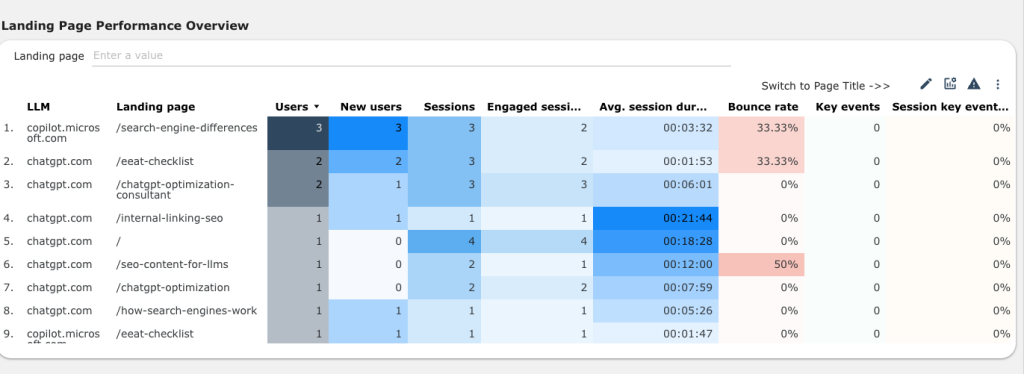For decades, search engine optimization (SEO) revolved around one question: where do we rank?
But in 2025, that’s no longer enough.
With the rise of AI-powered search, ChatGPT, Perplexity, Google AI Overviews, and Gemini, visibility is no longer measured by blue links alone.
Welcome to the era of AI SEO, also known as Answer Engine Optimization (AEO) or LLM SEO.
So how do you measure success in AI SEO?
Let’s break it down.
Why Traditional SEO Metrics Are No Longer Enough
In the AI search era, rankings are increasingly personalized, fragmented, and sometimes invisible.
Here’s why old-school metrics are fading:
- AI Overviews bury organic links beneath summaries, videos, People Also Ask, and more.
- Search behavior has changed: users ask longer, more conversational queries that LLMs fan out into multiple sub-questions.
- No two results pages are the same: personalization now dominates, making “average rank” meaningless in many cases.
What is AI SEO Success?
Success in AI SEO means:
- Being cited in AI-generated answers.
- Owning semantic space around key entities and topics.
- Showing up across multiple surfaces (Search, Maps, YouTube, Discover, etc.).
- Supporting complete “search journeys” from awareness to action.
Let’s dive into how to measure each.
1. Citation Frequency in AI Platforms
The number one indicator of success in AI search is whether you’re cited.
✅ ChatGPT & Bing Copilot
You may see this appearing in Google Analytics reports:
utm_source=chatgpt.com
This means that you can track referral traffic from ChatGPT.
ChatGPT’s browsing tool (powered by Bing) is now actively linking to websites and passing real UTM parameters when users click those links.
Even if it’s not showing up in bulk just yet, this matters. Because it means:
- ChatGPT is citing your content.
- People are clicking those citations.
- And yes, you can track it.
How to Measure:
- Search your site’s queries in GPT-4 with browsing enabled.
- Look for your domain in citation cards or linked passages.
- Use
utm_source=chatgpt.comin GA4 or BigQuery to segment traffic. - Check engagement: bounce rate, scroll depth, and conversion from this new cohort.
Want a simpler way to track it?
🧰 We built a free GA4 dashboard that shows your LLM referrals in one view, ChatGPT, Copilot, Perplexity, and more.
If AI is going to be the next big search engine, this is your version of Google Analytics circa 2003.
✅ Perplexity AI
Perplexity openly lists sources for each response.
To track:
- Note your domain appearance frequency in source listings.
- Search using both branded and unbranded queries.
- Analyze the passages that are being cited.
Perplexity’s “Pro Search” and “Copilot” modes offer more granular retrieval, often drawing directly from high-authority or structured content.
✅ Google AI Overviews & Gemini
AI Overviews are trickier to monitor due to a lack of consistent citation. However:
- Perform spot checks using target queries in incognito mode.
- Use Chrome’s “Copy with citation” feature to check if your content is cited behind the scenes.
- Monitor click-through volume and engagement on pages known to match AI answer structure (FAQ, HowTo, semantically-rich definitions).
Want a simpler way to track this traffic?
We built a free GA4 dashboard that shows your LLM referrals in one view, ChatGPT, Copilot, Perplexity, and more.

I’ll send the dashboard and setup guide straight to you.
2. Surfaceability & Passage Recall
Most AI answers pull 40–60 word passages that clearly answer a question. Your content needs to be:
- Bite-sized.
- Structured around sub-queries.
- Factual, direct, and attributed.
Measurement Indicators:
- How many of your pages contain passage-level answers to common sub-queries?
- How well is your content chunked for extraction?
- Do your headings reflect common query variants?
You can check this by prompting ChatGPT:
“What’s the best answer to [your topic] from [yourdomain.com]?”
If it pulls a clean paragraph, success. If not, your passage formatting may be off.
3. AI Share of Voice (SOV)
AI Share of Voice measures your presence across LLM answers relative to competitors.
You’re tracking:
- % of time your site is cited in a category (e.g., health, SaaS, eCommerce).
- How often your brand appears for transactional vs. informational queries.
- Entity association strength (e.g., are you cited next to other industry leaders?).
How to Track:
- Use Profound, ChatGPT Browsing, Perplexity, and Gemini spot checks.
- Build a benchmark list of 50–100 core queries.
- Record citations monthly.
- Calculate SOV per query type (brand, competitor, best-of, definition, pricing, etc.).
4. Ecosystem Visibility (Not Just Google)
AI SEO is about visibility across more than just Google:
- Gemini
- ChatGPT
- Perplexity
- YouTube (via transcript and passage extraction)
- Google Maps & Business Profiles (for local AI responses)
- Reddit, Quora, forums (as AI increasingly scrapes answers from community content)
Tactics:
- Perform direct prompts across platforms and monitor source appearances.
- Track social and YouTube citations in Gemini (Google increasingly prefers its own ecosystem).
- Embed structured data across media:
VideoObject,ImageObject, FAQ schema, etc.
The broader your visibility footprint, the stronger your AI retrieval likelihood.
5. Search Journey Completion
This is one of the biggest paradigm shifts: from keywords → entities → journeys.
Your content now needs to support full intent pathways.
Examples:
Entity: “Mount Fuji”
Journeys:
- How to hike it
- Best time to go
- Gear needed
- Accommodation nearby
- Cultural significance
Measurement:
- Are you covering all journey variants?
- Do users progress from one stage to the next via internal links?
- Are your passages being used to answer different types of questions (what, how, best, vs., pricing)?
Tools like Perplexity Copilot and Google’s Search Generative Experience (SGE) suggest user journey steps you can map against.
6. Brand Recall & Sentiment in AI
AI-generated answers increasingly serve as first-touch brand impressions.
Key indicators:
- Is your brand associated with trustworthy, expert, or innovative language?
- Does AI recall your brand accurately when asked “Who is [Brand]?” or “What does [Brand] do?”
- Are your brand mentions accompanied by competitors or used as the default answer?
You can test this by asking:
“What is the best alternative to [Brand]?”
“What’s the difference between [Brand A] and [Brand B]?”
“Should I use [Brand] for [use case]?”
If AI defaults to you, your brand authority is strong. If not, work on semantic reinforcement through third-party mentions, schema, and expert content.
7. AI Traffic Quality (If Clicks Exist)
Clicks from AI search are rare, but when they happen, they’re high-intent.
Track post-click behavior from AI sources:
- Bounce rate
- Time on page
- Conversion rate (leads, purchases)
- Page depth (how far they explore your site)
Even if click volume is lower, these metrics help prove that AI visitors are more qualified.
Monitor sources like:
- Bing (ChatGPT browsing)
- Perplexity referral domains
- Google Discover (for Gemini content)
- Branded search uplift (users who saw your brand via AI and searched it directly)
8. Engagement With Semantic and Structured Assets
AI retrieves from content types beyond HTML:
- FAQ schema
- Video transcripts
- HowTo schemas
- Tables and bullet lists
- PDFs and embedded widgets
Measure:
- Impressions and clicks on structured content
- Video view duration (if embedded and indexed)
- Direct citations from your PDFs or tools in ChatGPT or Perplexity
Embedding answer-ready media and schema makes you extractable, even when the AI can’t “see” your full page.
9. Content Freshness and Authority Scores
AI systems prioritise recent, reliable data. Outdated or generic content loses retrieval power.
Indicators to watch:
- Crawl recency (check GSC crawl stats)
- Indexation freshness (via URL Inspection tool)
- Content last modified dates in schema
- E-E-A-T signals (expert quotes, credentials, reviews, original data)
Audit regularly and prune or update low-value content to maintain high relevance across AI platforms.
10. AI SEO-Specific KPIs to Track
Let’s summarize some emerging KPIs you should consider building into dashboards:
| Metric | What It Shows |
|---|---|
| AI Citation Frequency | How often you’re used in LLM answers |
| AI Share of Voice (%) | Your visibility compared to competitors |
| Passage Recall Rate | % of content that’s extractable in 40–60 word snippets |
| Entity Coverage Score | # of journey variants covered per core topic |
| Ecosystem Visibility Index | Presence across Gemini, Perplexity, ChatGPT, YouTube, etc. |
| Sentiment Analysis (LLM) | Perceived tone of your brand in AI responses |
| Branded Query Uplift | Rise in branded search volume linked to AI mentions |
| AI-Referral Conversion Rate | On-site engagement of users who come from AI sources |
| Schema Coverage | % of content with semantic markup for AI engines |
| Journey Completion Metrics | Internal pathing across different intent stages |
Final Word: Success in AI SEO Is Multi-Dimensional
Ranking #1 on Google used to be the gold standard. But today, it’s just one piece of a broader puzzle. In the age of AI search, success is measured by your ability to be selected by AI search engines.
That means structuring content for retrieval, building semantic authority, showing up across platforms, and thinking beyond traffic into trust, visibility, and conversion.
The future of SEO is less about keywords, it’s about being the best answer, wherever the question is asked.


